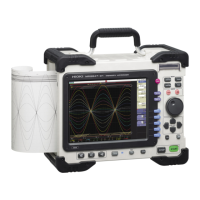Appendix 5 FFT Definitions
A15
Appendix
What is FFT? __________________________________________________
FFT is the abbreviation for Fast Fourier Transform, an efficient method to calcu-
late the DFT (Discrete Fourier Transform) from a time-domain waveform. Also,
the reverse process of transforming frequency data obtained by the FFT back
into its original time-domain waveform is called the IFFT (Inverse FFT). The FFT
functions perform various types of analysis using FFT and IFFT.
Time and Frequency Domain Considerations _______________________
All signals are input to the instrument as a function of the time domain. This func-
tion can be considered as a combination of sine waves at various frequencies,
such as in the following diagram. The characteristics of a signal that may be diffi-
cult to analyze when viewed only as a waveform in the time domain can be eas-
ier to understand by transforming it into a spectrum (the frequency domain).
Discrete Fourier Transforms and Inverse FFT _______________________
For a discrete signal x(n), the DFT is X(k) and the number of Analysis points is N,
which relate as follows:
X(k) is typically a complex number, so expression (1) can be transformed again
and written as follows:
Appendix 5 FFT Definitions
Amplitude
Frequency
Time
Time-Domain
Waveform
{}
kn
N
N
n
WkX
N
kXIDFTnx
−
−
=
==
1
0
)(
1
)()(
{}
)()()(exp)()( kkFkjkFkF
φφ
∠==
{}
{}
)(Re
)(Im
tan)(
1
kX
kX
k
−
=
φ
: Amplitude spectrum, : Phase spectrum

